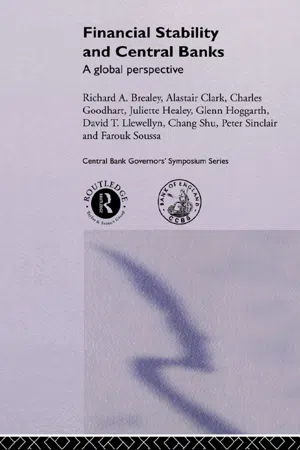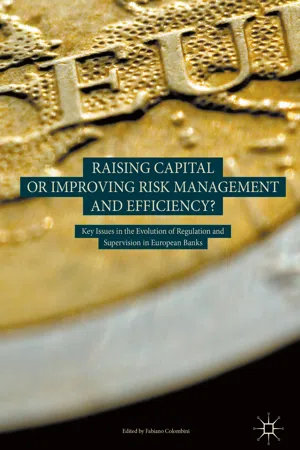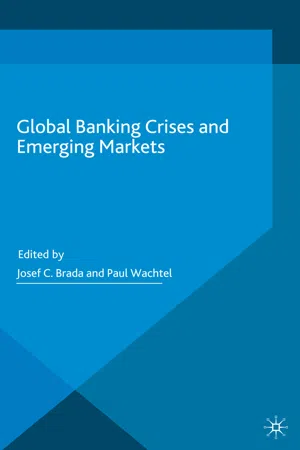Capital Requirements
Capital requirements refer to the minimum amount of capital that financial institutions, such as banks, are required to hold to ensure their stability and ability to cover potential losses. These requirements are set by regulatory authorities to safeguard the financial system and protect depositors and investors. Meeting capital requirements is essential for banks to maintain solvency and manage risk.
6 Key excerpts on "Capital Requirements"
- eBook - ePub
An Introduction to Banking
Liquidity Risk and Asset-Liability Management
- Moorad Choudhry(Author)
- 2011(Publication Date)
- Wiley(Publisher)
...Typically, an institution is subject to the regulatory requirements of its domestic regulator, but it may also be subject to cross-border requirements such as the European Union’s capital adequacy directive. 1 A Capital Requirements scheme proposed by a committee of central banks acting under the auspices of the Bank for International Settlements (BIS) in 1988 has been adopted universally by banks around the world. These are known as the BIS regulatory requirements or the Basel capital ratios, from the town in Switzerland where the BIS is based. 2 Under the Basel requirements all cash and off-balance-sheet instruments in a bank’s portfolio are assigned a risk weighting, based on their perceived credit risk, which determines the minimum level of capital that must be set against them. A bank’s capital is, in its simplest form, the difference between the assets and liabilities on its balance sheet, and is the property of the bank’s owners. It may be used to meet any operating losses incurred by the bank, and if such losses exceed the amount of available capital then the bank will have difficulty in repaying liabilities, which may lead to bankruptcy. However, for regulatory purposes capital is defined differently; again, in its simplest form regulatory capital is comprised of those elements in a bank’s balance sheet that are eligible for inclusion in the calculation of capital ratios. The ratio required by a regulator will be that level deemed sufficient to protect the bank’s depositors. Regulatory capital includes equity, preference shares and subordinated debt, as well as general reserves. The common element of these items is that they are all loss absorbing, whether this is on an ongoing basis or in the event of liquidation...
- eBook - ePub
The Money Markets Handbook
A Practitioner's Guide
- Moorad Choudhry(Author)
- 2011(Publication Date)
- Wiley(Publisher)
...These are known as the BIS regulatory requirements or the Basel capital ratios, from the town in Switzerland where the BIS is based. 2 Under the Basel requirements all cash and off-balance sheet instruments in a bank’s portfolio are assigned a risk weighting, based on their perceived credit risk, that determines the minimum level of capital that must be set against them. A bank’s capital is, in its simplest form, the difference between assets and liabilities on its balance sheet, and is the property of the bank’s owners. It may be used to meet any operating losses incurred by the bank, and if such losses exceeded the amount of available capital then the bank would have difficulty in repaying liabilities, which may lead to bankruptcy. However for regulatory purposes capital is defined differently; again in its simplest form regulatory capital is comprised of those elements in a bank’s balance sheet that are eligible for inclusion in the calculation of capital ratios. The ratio required by a regulator will be that level deemed sufficient to protect the bank’s depositors. Regulatory capital includes equity, preference shares and subordinated debt, as well as the general reserves. The common element of these items is that they are all loss-absorbing, whether this is on an ongoing or basis or in the event of liquidation. This is crucial to regulators, who are concerned that depositors and senior creditors are repaid in full in the event of bankruptcy. The Basel rules on regulatory capital originated in the 1980s, when there were widespread concerns that a number of large banks with cross-border business were operating with insufficient capital. The regulatory authorities of the G-10 group of countries established the Basel Committee on Banking Supervision. The Basel Committee on Banking Supervision’s 1988 paper, International Convergence of Capital Measurement and Capital Standards, set proposals that were adopted by regulators around the world as the “Basel rules”...
- eBook - ePub
Financial Stability and Central Banks
A Global Perspective
- Richard Brearley, Juliette Healey, Peter J N Sinclair, Charles Goodhart, David T. Llewellyn, Chang Shu, Richard Brearley, Juliette Healey, Peter J N Sinclair, Charles Goodhart, David T. Llewellyn, Chang Shu(Authors)
- 2001(Publication Date)
- Routledge(Publisher)
...As depositors increasingly acquired protection against bank failure, this ratio declined to about 10 per cent, 22 which is significantly less than the amount of equity maintained by finance companies, which do not enjoy implicit or explicit government guarantees. Capital Requirements seem to have contributed to stemming this decline in bank equity. For example, the average risk-weighted capital ratio of G-10 banks rose from 9.3 per cent before the 1988 Basel Accord to 11.2 per cent in 1996. Moreover, the greatest rises were experienced by those countries whose banks were close to, or below, the Basel minimum standards. 23 In most G-10 countries banks now hold more capital than the regulatory minimum. This may stem from the need for banks to preserve their credit ratings, in which case the capital requirement is immaterial. However, it seems more likely that the surplus capital reflects a perceived need to maintain a buffer to avoid the need for costly adjustments. 24 5.3.3 Prompt corrective action Imposing Capital Requirements will not prevent widespread bank failure; that depends on what actions are taken when Capital Requirements are breached. Delays in taking action encourage gambling for resurrection and the risk of much larger losses. 25 As long as the bank is wound up, sold or reorganised before its capital is exhausted, neither uninsured depositors nor the government need suffer loss. Uninsured depositors have less incentive to run and the risk of contagion is reduced. In the USA, the Federal Reserve had discretionary powers to limit the activities of banks that were capital-impaired, but prompt corrective action became mandatory only under FDICIA. FDICIA divides banks into five categories, varying from those that are ‘well-capitalized’ to ‘critically undercapitalized’...
- eBook - ePub
Raising Capital or Improving Risk Management and Efficiency?
Key Issues in the Evolution of Regulation and Supervision in European Banks
- Fabiano Colombini, Fabiano Colombini(Authors)
- 2018(Publication Date)
- Palgrave Macmillan(Publisher)
...© The Author(s) 2018 Fabiano Colombini (ed.) Raising Capital or Improving Risk Management and Efficiency? https://doi.org/10.1007/978-3-319-71749-4_5 Begin Abstract 5. Capital Constraints by Regulation in Europe Paola Ferretti 1 (1) Department of Economics and Management, University of Pisa, Pisa, Italy Paola Ferretti End Abstract 5.1 Introduction In order to ensure that a bank has a sufficient capital to conduct its business, taking into account the risks that weigh on banking institutions, each bank is required to respect the rules imposed by the supervisory authorities concerning capital adequacy. Therefore each bank is required to define the amount extent of its capital as well as the optimal combination of the capital instruments of which the capital itself is made up. Additionally, banks are required to classify and measure and/or assess the various risk types and take into account the relationship between capital and level of risk. This chapter aims to analyse the evolution of the rules on banking capital adequacy, from Basel I to Basel III, as well as the latest developments on this issue (the forthcoming Basel IV). 5.2 Capital Rules: Nature, Origins and Aims In general, capital serves as a foundation for a bank’s future growth and as a cushion against unexpected losses. Adequately capitalised and well-managed banks are in a good condition to withstand losses and, furthermore, to provide credit to the economy throughout the business cycle. Adequate levels of capital help to promote public confidence in the banking system. Therefore, from the point of view of the banks and the supervisors, it is crucial to determine how much capital is necessary to serve as a sufficient buffer against unexpected losses...
- eBook - ePub
- Michele Chang, Georg Menz, Mitchell P. Smith, Michele Chang, Georg Menz, Mitchell P. Smith(Authors)
- 2016(Publication Date)
- Routledge(Publisher)
...Clearly, British banks were concerned about the implications of higher Capital Requirements and struggled to raise capital. However, they were in a better position — on average — than most of their French and German competitors and the British government was less preoccupied with the impact of Basel III rules upon the British economy because of earlier deleveraging. The implementation of the Basel III rules on Capital Requirements is politically controversial in the EU and the negotiations on the new EU legislation are — as of mid-February 2013 2012 — ongoing. The intergovernmental politics of the CRDIV provides a useful case study of the importance of political economy explanations that undermine EU-level efforts to construct financial regulation that effectively stabilises the EU banking system. A conclusion of this article of relevance to this special issue is that the construction of EU economic governance is bound to be less effective than sought because of the diverging implications of EU-level rules for national economies. This core economic fact casts doubt on the ability of the EU to satisfy both markets, by facilitating cross border financial integration, and politics, through the provision of the public good of financial stability. Notes 1. Capital represents the portion of a bank’s assets which have no associated contractual commitment for repayment. It is, therefore, available as a cushion in case the value of the bank’s assets declines or its liabilities rise. 2. Liquid assets are cash or any other negotiable assets that can be quickly converted into cash. 3. There are wider questions being asked about the whole foundation on which the Basel agreement is built — i.e., risk weighted assets — hence the desire for the leverage ratio which looks at over-all assets. References Allen, F., and D. Gale. 2000. Comparing financial systems. Cambridge: MIT press. Barker and Masters 2012. The reference in the bibliography should be: Barker, A. and B. Masters. 2012...
- eBook - ePub
- Josef C. Brada, Paul Wachtel, Josef C. Brada, Paul Wachtel(Authors)
- 2015(Publication Date)
- Palgrave Macmillan(Publisher)
...A country desiring to substitute capital rules for reserve requirements is in this spirit well advised to bring the cost of capital and the risk of default down to acceptable levels. Only when Capital Requirements can successfully reduce bank risk behaviour can financial repression harmlessly be diminished. Our simple analysis of the available Russian data suggests, but does not establish proof of, a perverse impact of Capital Requirements with respect to risk behaviour of Russian banks. The Russian supervisory authorities may have fallen in this pitfall explained by our model. The temporary increase of reserve requirements of the CBR in the aftermath of the crisis of August 1998, although heavily criticised, may therefore have been very useful in curbing bank risk behaviour and securing systemic stability. Acknowledgements Rudi Vander Vennet acknowledges financial support from the Programme on Interuniversity Poles of Attraction of the Belgian Federal Office for Scientific, Technical and Cultural Affairs, contract No. P5/21. The views expressed in this paper are those of the authors and should not be interpreted as reflecting the views of the Executive Board of Sveriges Riksbank. We wish to thank all participants to the Ghent 2006 conference on ‘Risk, Regulation and Competition: Banking in Transition’ and two anonymous referees for comments and suggestions. Notes 1. Emerging financial markets often tend to be restricted by rules governing the composition of bank balance sheets, such as high reserve requirements, interest-rate ceilings, foreign-exchange rate regulations and other types of explicit or implicit taxes on the financial sector (Denizer et al., 1998). For an analysis of the optimal degree of financial repression, see, for example, Bencivenga and Smith (1992), who develop a model in which an increase in reserve requirements represses the development of the financial system. 2. See for example Rochet (1992) and Dewatripont and Tirole (1994). 3...





